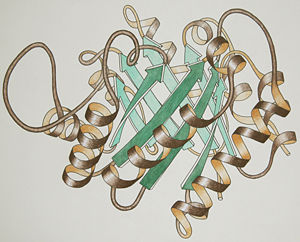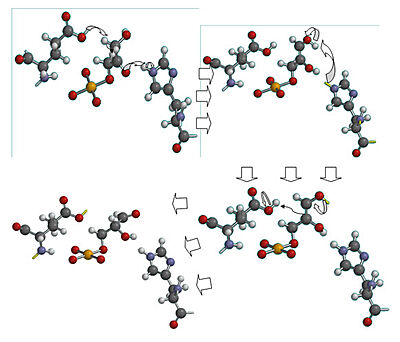Triose Phosphate Isomerase Structure & Mechanism
From Proteopedia
(Difference between revisions)
| (5 intermediate revisions not shown.) | |||
| Line 2: | Line 2: | ||
[[Image:TriosePhosphateIsomerase_Ribbon_pastel_photo_small.jpg|thumb|left|300px|Ribbon drawing for one chain of the "TIM barrel" fold]] | [[Image:TriosePhosphateIsomerase_Ribbon_pastel_photo_small.jpg|thumb|left|300px|Ribbon drawing for one chain of the "TIM barrel" fold]] | ||
| + | <br /> | ||
| + | |||
===General Information=== | ===General Information=== | ||
Triose phosphate isomerase (TIM)<ref>PMID:16511037</ref><ref>PMID:8061610</ref> (PDB [[1wyi]] and [[1hti]]) is a crucial enzyme in the glycolytic pathway. <scene name='Christian_Krenk_Sandbox/Nc_rainbow/1'>TIM</scene> reversibly converts the aldose Glyceraldehyde-3-phosphate (GAP) to the ketose Dihydroxyacetone phosphate (DHAP). The interconversion proceeds by an enediol intermediate. Triose phosphate isomerase is not directly regulated, but the enzyme two steps before it in the glycolytic pathway, phosphofructokinase, is a heavily regulated, irreversible enzyme. | Triose phosphate isomerase (TIM)<ref>PMID:16511037</ref><ref>PMID:8061610</ref> (PDB [[1wyi]] and [[1hti]]) is a crucial enzyme in the glycolytic pathway. <scene name='Christian_Krenk_Sandbox/Nc_rainbow/1'>TIM</scene> reversibly converts the aldose Glyceraldehyde-3-phosphate (GAP) to the ketose Dihydroxyacetone phosphate (DHAP). The interconversion proceeds by an enediol intermediate. Triose phosphate isomerase is not directly regulated, but the enzyme two steps before it in the glycolytic pathway, phosphofructokinase, is a heavily regulated, irreversible enzyme. | ||
| Line 14: | Line 16: | ||
<scene name='Christian_Krenk_Sandbox/Active_site/1'> Glu 165 acts as the base and grabs the C2 proton on glyceraldehyde-3-phosphate, while His 95 is H-bonded to the carbonyl oxygen and acts as the acid by protonating carbonyl oxygen.</scene> The enediol intermediate is negatively charged, but is somewhat <scene name='Christian_Krenk_Sandbox/Lysine/1'>stabilized by the positively charged side chain of Lys 12.</scene> <ref name= "lodi">PMID:8130193</ref> Mutation of Lys 12 to Arg increases Km by a factor of 22 and decreases Vmax by a factor of 180.<ref name="lodi" /> To convert the enediol intermediate to DHAP, C1 is protonated by Glu 165, with His 95 removing a proton from C2’s OH group. As a result, the catalytic groups are back to their original states, and catalysis is complete. With GAP as a substrate, Km for the reaction is .34 mM and Vmax is 7200 units/mg protein at 25 degrees C and pH 7.5.<ref name= "dab" /> | <scene name='Christian_Krenk_Sandbox/Active_site/1'> Glu 165 acts as the base and grabs the C2 proton on glyceraldehyde-3-phosphate, while His 95 is H-bonded to the carbonyl oxygen and acts as the acid by protonating carbonyl oxygen.</scene> The enediol intermediate is negatively charged, but is somewhat <scene name='Christian_Krenk_Sandbox/Lysine/1'>stabilized by the positively charged side chain of Lys 12.</scene> <ref name= "lodi">PMID:8130193</ref> Mutation of Lys 12 to Arg increases Km by a factor of 22 and decreases Vmax by a factor of 180.<ref name="lodi" /> To convert the enediol intermediate to DHAP, C1 is protonated by Glu 165, with His 95 removing a proton from C2’s OH group. As a result, the catalytic groups are back to their original states, and catalysis is complete. With GAP as a substrate, Km for the reaction is .34 mM and Vmax is 7200 units/mg protein at 25 degrees C and pH 7.5.<ref name= "dab" /> | ||
| - | [[Image:ckrenkmechanism.jpg|left|thumb| | + | [[Image:ckrenkmechanism.jpg|left|thumb|400px| '''Mechanism of Triose phosphate isomerase'''. Created by Christian Krenk using Spartan 08.]] |
An interesting part of the enzyme is the <scene name='Christian_Krenk_Sandbox/Flexible_loop/1'>flexible loop</scene> that stabilizes the enediol-like transition state. The flexible loop (residues 167-176)<ref>PMID:2204418</ref> closes over the active site like a hinged lid when substrate is bound, thus preventing phosphate from leaving. A four-residue segment of the loop H-bonds with the phosphate group of the substrate.<ref name="book" /> Without the loop, the enediol intermediate would eliminate phosphate, with the end products being inorganic phosphate and toxic methylglyoxal.<ref name="book" /> | An interesting part of the enzyme is the <scene name='Christian_Krenk_Sandbox/Flexible_loop/1'>flexible loop</scene> that stabilizes the enediol-like transition state. The flexible loop (residues 167-176)<ref>PMID:2204418</ref> closes over the active site like a hinged lid when substrate is bound, thus preventing phosphate from leaving. A four-residue segment of the loop H-bonds with the phosphate group of the substrate.<ref name="book" /> Without the loop, the enediol intermediate would eliminate phosphate, with the end products being inorganic phosphate and toxic methylglyoxal.<ref name="book" /> | ||
Current revision
| |||||||||||
References
- ↑ Kinoshita T, Maruki R, Warizaya M, Nakajima H, Nishimura S. Structure of a high-resolution crystal form of human triosephosphate isomerase: improvement of crystals using the gel-tube method. Acta Crystallogr Sect F Struct Biol Cryst Commun. 2005 Apr 1;61(Pt, 4):346-9. Epub 2005 Mar 24. PMID:16511037 doi:10.1107/S1744309105008341
- ↑ Mande SC, Mainfroid V, Kalk KH, Goraj K, Martial JA, Hol WG. Crystal structure of recombinant human triosephosphate isomerase at 2.8 A resolution. Triosephosphate isomerase-related human genetic disorders and comparison with the trypanosomal enzyme. Protein Sci. 1994 May;3(5):810-21. PMID:8061610
- ↑ 3.0 3.1 Dabrowska A, Kamrowska I, Baranowski T. Purification, crystallization and properties of triosephosphate isomerase from human skeletal muscle. Acta Biochim Pol. 1978;25(3):247-56. PMID:752201
- ↑ 4.0 4.1 4.2 Voet, Donald, Judith G. Voet, and Charlotte W. Pratt. Fundamentals of Biochemistry Life at the Molecular Level. New York: John Wiley & Sons, 2008. p. 495. Print.
- ↑ 5.0 5.1 Lodi PJ, Chang LC, Knowles JR, Komives EA. Triosephosphate isomerase requires a positively charged active site: the role of lysine-12. Biochemistry. 1994 Mar 15;33(10):2809-14. PMID:8130193
- ↑ Lolis E, Petsko GA. Crystallographic analysis of the complex between triosephosphate isomerase and 2-phosphoglycolate at 2.5-A resolution: implications for catalysis. Biochemistry. 1990 Jul 17;29(28):6619-25. PMID:2204418
7. Wierenga RK, Kapetaniou EG, Venkatesan R. Triosephosphate isomerase: a highly evolved biocatalyst. Cellular and Molecular Life Sciences. 2010 August 7 67:3961-3982. PMID: 20694739 [1]
Proteopedia Page Contributors and Editors (what is this?)
Christian Krenk, Alexander Berchansky, Diamond B. Reese, Michal Harel, Jane S. Richardson, David Canner


